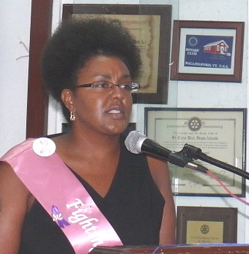
Don’t make excuses, don’t put it off and don’t worry, you’re probably fine. But the earlier cancer or any precancerous conditions are found, the better off you’ll be.
Dr. Jacqueline Thompson, a surgeon on St. Croix, spoke frankly to St. Croix Rotary West Club Tuesday about the myths and realities of breast cancer, highlighting again and again the importance of regular testing of women over 40. Every year, almost 180,000 women in the U.S. are diagnosed with breast cancer and more than 40,000 die from it.
But early detection makes a great deal of difference in prognosis and in quality of life. The biggest risk factor is simply being a woman. Men do suffer the disease, but at less than one percent the rate women do.
On St. Croix and in the Virgin Islands, people often seek care off island, Thompson said. But she sees and performs surgery on many patients who either choose not to travel or who don’t have that option.
And what she sees makes her advocate testing all the more. If caught early, often a person can survive 25 years or more before dying of something else.
"About once a week we see someone come in who has delayed getting treatment," she said. "Then the fatality rate is 100 percent."
"If we can’t cure it, we can treat it and help the person live with the disease," she said. "Cancer victims don’t have to suffer; they can live and live well with the disease."
Often patients will feel that if there are no symptoms and they don’t feel anything, they don’t need the test, she said. But the mammogram does not treat or prevent cancer; it helps detect and confirm its presence, and the less there is to detect, the better off you are when you start treatment.
Some women prefer the sonogram because it is less uncomfortable. Ultrasound is also an important diagnostic tool, though it is not a substitute but a complementary tool, Thompson said. A woman in her early 20s who has sore spots or other symptoms may have an ultrasound sonogram, because the mammogram may not be able to get a good image. But as women age, the diagnostic reliability of mammograms progressively improves.
And if you can say the pain is right in one spot, a sonogram can be very effective, but if symptoms are more diffuse, a mammogram is better.
"I’m not going to say it’s comfortable; yes they cause pain but go get your mammogram anyway," she said. "And once you get it, don’t walk away with a sigh of relief thinking now I don’t have to go again for the rest of my life. You need to come back for one every one to two years."
On St. Croix, the Imaging Center in Island Medical Center at Sunny Isles performs mammograms. On St. Thomas, Schneider Regional Medical Center has them, as does one private clinic. There is an appropriation bill for a second one on St. Croix moving through the Legislature at this time, sponsored by Sen. Nereida "Nellie" O’Reilly.
Treatment varies but largely is surgery, then traditional chemotherapy or radiation therapy or some combination. After the initial treatment, there is generally a regimen of hormone therapy lasting for two to five years. While the territory’s cancer treatment center is on St. Thomas, residents of St. Croix do not have to leave the island for everything; much of the treatment is on St. Croix, too.
Thompson and others perform surgery. And an oncologist based at St. Thomas’s Charlotte Kimelman Cancer Institute keeps regular office hours in Sion Farm on St. Croix where she offers traditional chemotherapy. St. Thomas, however, does have the whole range of radiation therapies, Thompson said.
Along with testing for breast cancer, Thompson urges everyone older than 50 to be tested for colon cancer. If you have any family member who has ever had the disease, start at 45, she said.
"When detected early, it’s often the size of a little green pea and is 100 percent curable," she said.
The procedures are relatively minor and not traumatic. But she sees far too many patients coming in when they are already very sick, and then it is a very different story.
A mammogram costs between $120 and $200, and is covered by Medicare, Medicaid and private insurance. There are also periodic free screenings which can be found in the community calendar in the Source and other newspapers. Too few come out to the free clinics, which could serve many more patients than they do, she said.
A colonoscopy is a more expensive procedure, and it may even be cost effective to travel off island for it.
October is Breast Cancer Awareness Month, so more attention is given to the disease and to testing. But a woman older than 40 who hasn’t had one can get the test in November too. There is no benefit to putting it off, Thompson said.
Doctor: Women Should Get Annual Mammograms for Safety
Keeping our community informed is our top priority.
If you have a news tip to share, please call or text us at 340-228-8784.
If you have a news tip to share, please call or text us at 340-228-8784.
Support local + independent journalism in the U.S. Virgin Islands
Unlike many news organizations, we haven't put up a paywall – we want to keep our journalism as accessible as we can. Our independent journalism costs time, money and hard work to keep you informed, but we do it because we believe that it matters. We know that informed communities are empowered ones. If you appreciate our reporting and want to help make our future more secure, please consider donating.





